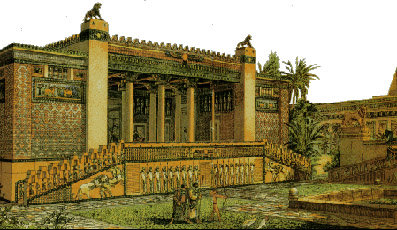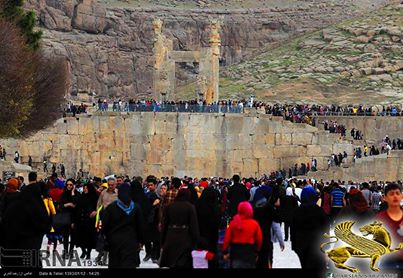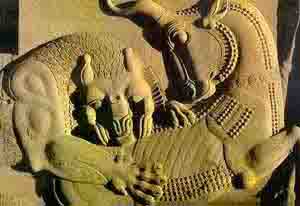Getting to know Persepolis (پارسه) Immortal works of the Achaemenians
The glorious Achaemenid capital of Persepolis, a capital whose ruins show the glory of Iranian rule even to this day..
This capital has a long and ups and downs story . In this article, we discuss the sad end of this manifestation of Iranian art.
Dr. Sami writes about Persepolis and its end:
( Takht Jamshid, with all its splendor, beauty and glory, like many buildings like it, was not removed from the way and customs of nature, which destroys every being and destroys every building. His greatness did not last for more than one hundred and eighty years, and at the end, he was burned by wild fire and brutality, and was left to destruction and oblivion.)
Page 354 of the book Capitals of Achaemenid Emperors by Dr. Ali Sami
But is Persepolis really burned?
In the following, we will examine the evidence found as a result of excavations in Persepolis, which is related to the issue of burning..
The effects of fire in Persepolis
Dr. Sami, who is the founder of the Persepolis Scientific Institute, took over the presidency of this institute in 1319 after the departure of Dr. Isa Behnam, and continues the excavations and archaeological explorations after the scientific group of the Chicago Institute.(Page 126 of the book Persepolis in Contemporary History written by Mohammad Hassan Talebian) He writes about the burning of Persepolis and the traces of the fire found:
( The burning of the palaces of Persepolis by Alexander the Great has been confirmed during the thirty years of excavations there.. As the writers of Alexander's time and other Greek and Roman historians have written, this huge palace was burned and looted, and only the passing of time and the change of times should have destroyed and disintegrated such a strong and beautiful building.. In the palaces, corridors and porches, the sides of the walls and the floors of the halls were everywhere piled with dirt, the effects of burning and smoke, charcoal, half-burnt wood, and burnt cloths were visible, which leaves no room for doubt..
Not only in the works on the Sefa, but also in the open buildings outside the Sefa, whose description was passed[The doctor's reference to the previous contents of the book] The effects of burning and burning were seen everywhere, and now some of the burnt curtains, carpets and wood found in the excavations are available in the Persepolis Museum.)
(Page 354 of the book of Achaemenid kings' poems written by Dr. Ali Sami)
Many traces of charcoal and ash between 70 centimeters and 2 meters, which were observed in the central hall and the northern porch of the Hundred Column Palace, showed that this palace was more than other palaces that was subjected to the terrible fire of Alexander..
( Semitic capitals of Achaemenid kings page 209)
Dr. Sami also writes about the Hall of Hundred Columns in his book:
(Stolze stolze that about ninety years ago(Before the scientific explorations of Persepolis) The palace was destroyed and destroyed by Haj Motamed al-Dawlah Farhad Mirza (The year 1295 AH equals 1877 AD) He saw and wrote that the floor of the hall was made of one layer of coal and ashes of burnt objects and rotten wood. In addition to our excavations, there were signs and traces of severe burns on the floor of this hall.)
page 184 of the book Capital of the Achaemenid Emperors and see stolze and andreas.persepolis,11-2
Dr. Shahbazi, who himself was the founder of the Achaemenid Research Group, and through this group, since November 1353, he has been following extensive executive, research and restoration works in Persepolis.(Pages 185, 186, and 187 of the book Persepolis in Contemporary History written by Mohammad Hassan Talebian) He writes about fire:
(The evidence shows that the Palace of Hundred Columns was probably the most damaged during the fire of Iskandar)
Shahbazi Documentary guide of Persepolis page 166
So, according to archaeological excavations, the cause of the destruction of all the glory in Parse was a terrible fire, and ancient historians report that this fire was ignited by Alexander..
In the following, we will give a short selection of the writings of ancient historians about fire and examine the causes of fire..
The story of the burning of fire in Parse according to historians:
Radet, one of the best historians of Alexander, narrates the details of the incident as if he had seen it with his own eyes and says:
(( The royal city, which was the center of court splendor during the Achaemenid period, was the best place for the Macedonians to celebrate their incredible war victories.… Indeed, where he (اسکندر) He thanked his gods and men, offered sacrifices to the gods, and lavish feasts to his men. These feasts were frequent, one of which was actually the last of all, they went crazy and reveled…At this time, the scene changed . Until then, the course of events was under the spiritual congregation of Zeus, but gradually, when the cups were emptied and the heads were spinning, Bacchus, the god of wine, showed himself and gave the audience drunken madness and lust, and caused everyone to be disturbed and misled. The party turned into a crowd of crazy people and everyone succumbed to delusion… Twenty-one (Alexander's mistress) He invited Iskandar to open the Komus ceremony with others. He also wanted to participate in it with enthusiasm. Iskandar agreed and after him, Tays moved the group of Rameshgaran and assumed the role of their leader, and Komus sang and sang. Flute left the banquet hall. Others followed them and got some torches and surrounded the palace that they wanted to set fire to. First Iskandar and then Tays threw the burning torches on the building whose woodwork was made of cedar wood. . Everyone followed them and the fire spread everywhere.))
(george's row)
( The text is quoted from pages 366 and 365 of the book Capitals of Achaemenid Emperors)
Plutarch wrote that Ptolemy's mistress Tays gave a speech and then they set fire to the palace, but Alexander soon regretted this act and ordered to put out the fire..
Plutarch witnessed Dryden's famous poems and it is like this:
( Timotheus shouts:revenge . revenge. See the spirits of revenge that have arisen … See how they raise the torches, how the Persian dwellings and shining temples show their opposing gods. The princes praised the angry lord. The king took hold of the flame to destroy, Tays guided him and brought him to his desired, like Helen, he burned another Troy..)
Page 349, the first volume of the book History of Iran, authored by Sarpersi Sikes
Arian says:( Iskandar in response to one of the generals (Parman Yen) who believed that the looting and burning of Persepolis would tarnish his conquests, he said:An army from Persia came and destroyed Athens and burned its temples. I must avenge this deed. )
Page 374 of the book Capitals of Achaemenid Kings written by Ali Sami
Herodotus repeatedly said that the destruction of the Temple of Athens by Xerxes was a result of a sense of revenge that he wanted to kill the Athenians who burned the sacred forest of Sardis because the Persians considered Asia to be theirs and the people there were under their protection..
Page 374 of the book Capitals of Achaemenid Kings written by Dr. Ali Sami
What was the main reason for arson in Parse?
According to the above writings and historians' narratives, the cause of arson in Parse can be generally divided into two categories.:
1- Historians who believe that Alexander started the fire in Parse in revenge for the burning of Athens by Xerxes.
2- Historians who believe that this arson was caused by Alexander's drunkenness, and even after burning the palaces, he regretted it.
Now we will examine the writings of these historians to see what was actually the main cause of the arson?
First, we will examine the speech of the first category and examine if Iskandar's intention was revenge?
In general, in the ancient world, revenge and killing after conquest was a common practice. For example, Sennacherib, the king of Assyria, proudly describes his conquests in Elam like this.:((34. I besieged and attacked countless fortresses and cities that were subordinate to them and took their inhabitants captive and turned the place into a pile of ashes.. I spread the smoke of the fire to the sky like the smoke of a sacrifice…))(Page 355 of Achaemenid Capitals book) Like this practice by Ashurbani Pal also reappeared in the war so that Ashurbani Pal proudly says in the tablets:
(Within one month and twenty-five days, I ruined and destroyed this land and sprinkled thorns and briars in it)
Page 356 of Achaemenid Capitals book
But contrary to the custom of the time, when the victorious rulers and powerful people did not show the slightest mercy to the defeated nation, the Achaemenid kings broke the tradition and left a good way and ceremony, as Cyrus the Great says in his charter.:
(…When I entered Babylon without a fight, I sat on the king's throne with the happiness and joy of the people in the palaces of the kings. Marduk, the great lord, draw the pure hearts of the people of Babylon to me, because I have been thinking of his prayers every day. My great troops rest in peace. They entered Babylon, I didn't let hostility to Sumer and Akkad))(Page 358 of the book of Achaemenid capitals)
This good custom, which means respecting the religion and beliefs of the defeated and defeated nation and not killing and looting the people of that nation, was also followed by the son of Cyrus, Kambojie, so that the hieroglyphic inscriptions on the headless statue belonging to the son of the high priest It was written in Egypt:((…I ordered the king[Cambodia]… I fed the children. I did useful things for the needy and orphans…)(Mohammad Panah Behnam 1384 The secrets of ancient Egyptian civilization)
This procedure was followed by other Achaemenid kings, but the conspiracy of the Greeks caused the city of Athens to be burned by Xerxes..
(( In the last years of Darius's reign (494 BC) The Yanians, who lived in the European part of the Achaemenid government and on the islands and shores of the Greek sea, revolted at the instigation of the Athenians and burned the city of Sardis, the capital of Lydia, and as a result the famous temple of Sibel, which was one of the sacred and respected temples of this people. Its sacred forest caught fire and burned)) (Page 360 of the book Capitals of Achaemenid Emperors)
The news of this secret stare and the brutal and unexpected behavior of the Greeks hit the great king Dariush hard. Dariush knew that the Greeks on the coast of Asia Minor alone were not capable of such audacity, but they had resorted to such stares at the instigation of the Athenians.. So he decided to cover up the founders of this attack and put him in his place. He put the Yenians in their place, but death did not allow him to punish the Athenians. ((This is a bitter memory of Dariush's successor(Xayarsha) He did not go and waited for the opportunity . Fourteen years later, in 480 BC before the battle of Salamis, when the Iranian troops entered Athens, they set fire to its holy citadel, this was a reaction to the burning of the temple and the sacred forest of Sardis, and at that time the Iranian soldiers said:[ We learned this lesson from the Greeks]))(Page 360 of the book Capitals of Achaemenid Kings)
Thus, it is clear that the custom of revenge was not in the nature of Iranians, but a series of events caused Xerxes to make a wrong decision, and he later realized his mistake and ordered the reconstruction of Athens..
Dr. Ali Sami, head of the Persepolis Scientific Foundation, writes about the burning of Persepolis:
(Greek historians have tried to Alexander for this reason [Arson in Parse]They pretended that the fire of Persepolis was a revenge for the fire of the temple of Athens . While one hundred and fifty years had passed between these two events, and several generations had changed, and the memory of the wars between the Persians and the Greeks had faded and been forgotten, just as it is now in our time, despite the existence of many well-written histories and the existence of printed books. And the newspaper of the past events is gradually forgotten until it reaches the events of 150 years ago)
Even if the memory of such an event still remains, the Greeks themselves knew better than anyone that they started arson in Sardis first, and Xerxes also set fire to the temple of Athens in retaliation and revenge, so there is no more reckoning and grudge left. It will not last until they want to retaliate by burning Parse's fire.
According to the above information and the great distance between the burning of Athens and Alexander's arson in Parsa, then, in general, the claim of Greek historians about Alexander's revenge is false and this myth-telling was to make Alexander appear justified and to make Alexander appear oppressed to reduce the burden of Alexander's guilt. Is.
Now we will examine the second statement of the Greek historians about the burning of Persepolis, i.e. the burning of Persepolis in a drunken state at the request and temptation of Alexander's mistress. .
Professor Godard after quoting Radt's material[Your writings are quoted above] He comments like this:
(( This was the description of how Persepolis was set on fire and destroyed according to the narrations of Diodorus Rodet, Count Kurth, and Plutarch. But this is nothing more than a legend. Now we know the truth and that is that the palaces of Persepolis were looted in an orderly fashion. It was taken with care and this practice is assumed((Unforeseen incident)) rejects . The objects that were discovered during the 20 years of excavations that are still going on in the Safae of Persepolis do not even fill one of the showcases of the Tehran Museum.(This was said by Dr. Godar in 1330, when the excavations continued) In addition, no evidence was found there that was the reason for the excess of wind blowing, and this is something that, if it is true, seems strange. Camel loads of booty left the palaces of Persepolis. Then the buildings of Persepolis were cruelly and brutally set on fire.. If after that the legend of the accidental destruction of Parse was invented and repeated by a number of writers, and if this legend has come to this day and age with certainty in the form of a historical fact.. It was for this reason that during the rule of the Seleucids and later the Greek-friendly Parthians, it became necessary to wash the memory of Alexander's operation in the minds of the Easterners and lighten the burden of the Greeks' guilt in this work, as the defense lawyer claims in the court that his client during He committed the crime while drunk, so he was not fully responsible for his sin.))(page 148 of the Iranian Art book by Andre Godar and also look at page 366 and 368 of the Achaemenid Capitals book)
So, the second claim of Greek historians regarding arson in a drunken state is also completely rejected.
But what was the real reason for this arson?
Contemporary historians today say that this arson was intentional and completely planned, as Neld says.:((Contrary to popular opinion, I believe that the burning of the police press citadel was intentional and Alexander wanted to let the Asians know that their empire was completely ruined and that Alexander was their only master from now on.))(Page 372 of Achaemenid Capitals book )
Dr. Sami also says:(By burning the huge palace of the Achaemenid Empire, Alexander the Great wanted the people to understand that this dynasty was destroyed and to forget its memory. to strengthen and intensify and create disturbance and rebellion for him)
Page 362 of the book of the capitals of the Achaemenid kings
So today, we have come to the conclusion that this arson attack, contrary to the statements of the historians of the Greek legend, was not for revenge, nor for drunkenness, but to reduce the resistance and persistence of the Iranians against the Greek conquerors, and the purpose was to disappoint Iranians have not found independence again.
At the end, we see an inscription of Sultan Ali Aq Qoyunlu, which was carved in the year 881 AH and 889 AH in the Techer Palace.:
The talk of the world, if he wishes, he will do it with us
He who lived in this soil became soil, what does the soil know about what is in this soil
Every page is a free face, every step is a difference of Malekzadeh
This article is from Korosh Shahraki
(( Books and letters))
1- Shapour Shahbazi. Alireza(۱۳۸۴)Guide to the documentary of Persepolis. Tehran- Parse Research Foundation . Pasargad
2- Sami Ali.(۱۳۴۸) The capitals of Achaemenid kings, Shiraz:Shiraz university
3- Sami Ali.(۱۳۸۹) The capitals of the Achaemenid emperors, Tehran, Pazineh
4- Talebian Abdul Hossein(۱۳۹۳) Persepolis in contemporary history, Shiraz, Navid Publications, Shiraz
5- Iranian art book written by Andre Godard and translated by Dr. Behrouz Habibi
6- Sikes supervision(۱۳۲۳) History of Iran . Translated by Seyyed Mohammad Taqi Fakhrdaei. Tehran print
۷-George's row:Critical Notes on The History of Alexander Second Series(1927) 110-114
8-Muhammad Panah. in the name of (۱۳۸۴) The secrets of ancient Egyptian civilization. Tehran translated by Sabzan







